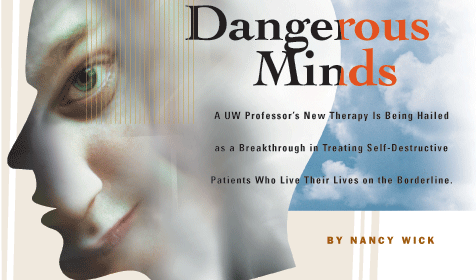

She was raised to help the poor and the suffering. She would have become a priest if the Catholic Church had allowed it. She attended a Jesuit university. So maybe it’s not surprising that Marsha Linehan’s youthful ambition was to help those she thought of as “the most miserable people in the world”—people who wanted to kill themselves.
“I never wrote a college paper on another topic,” she says. “No matter what the course was, I figured out a way to write about suicide.”
Forty years later Linehan—a UW professor of psychology and director of the Behavioral Research and Therapy Clinics—has developed a new therapy to help suicidal people decide to live and even thrive. She calls her method dialectical behavior therapy, or DBT, and there is a Hegelian tension in it—one part urges Zen-like acceptance while another part promotes change. Linehan’s work has been called “one of the most popular new psychotherapies in a generation” by the New York Times.
The particular people Linehan treats have borderline personality disorder, an obscure but relatively common malady afflicting about 2 percent of the U.S. population. Think of the most volatile person you know, then multiply the emotional intensity several times and you have a description of someone with this disorder. With an inability to recognize and deal with their own emotions, borderlines careen rapidly from clinging to others to lashing out at them, resulting in lives littered with the wreckage of failed relationships.

But the damage goes beyond the personal sphere because borderlines put a tremendous strain on the mental-health system. They are at high risk for both suicide attempts and less lethal self-harm, such as repeatedly cutting or burning themselves. They are hospitalized often and are also prone to eating disorders and substance abuse. Many borderlines suffer from the after-effects of sexual abuse in childhood. (Although about 75 percent of borderlines seeking treatment are women, Linehan speculates that male borderlines may have directed their destructive impulses at others instead of themselves and thus may be in jail.)
“You can’t decide to not treat these people,” Linehan says. “When someone tries to commit suicide, you have to respond.” If she was looking for the most miserable people in the world, she certainly found a group who could compete for the title.
She also found a group that desperately needed a new treatment plan. Borderlines, Linehan says, often get worse in traditional therapy. Moreover, their behavior with therapists hasn’t won them many champions. They call therapists names and question their motives. They miss sessions and drop out on the slightest pretext. And there is the ever-present threat of suicide.
In return, therapists have sometimes stigmatized people with the disorder. Shireen Rizvi, a former Linehan graduate student, says her undergraduate abnormal psychology textbook illustrated the description of borderlines with a photo of Glenn Close in Fatal Attraction. “The idea of associating the most extreme and fictional case with borderlines is typical,” she says. “In clinical work, I’ve seen people diagnosed as borderline because you don’t like them or they cause problems for you.”
In the past some clinicians have even questioned whether borderline personality disorder is a legitimate diagnosis. Maybe these people were just manipulative; they could change their behavior if they chose to.
Go To: Page 1 | Page 2 | Page 3